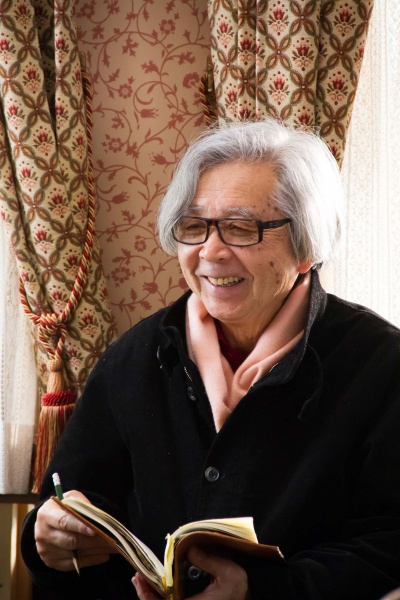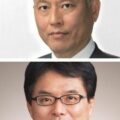“Abdication” Is Not Easy
If it is the Emperor’s intention, it is extremely exceptional

Hara Takeshi
HARA Takeshi (HT): I was literally astonished at the news “Emperor Intends to Abdicate.” When the news was aired on NHK at 7pm on July 13, I happened to have the TV on and, as I was watching it dumbfounded, I started receiving phone call after phone call from the press asking for comments.
KAWANISHI Hideya (KH): I can no longer stand to watch TV. (Laughing)
HT: That’s just not possible any more.
The reason I was surprised is that Article 2 of the Japanese Constitution states that “The Imperial Throne shall be dynastic,” and Article 4 of the Imperial House Law, which prescribes matters such as the method of succession, states that “Upon the demise of the Emperor, the Imperial Heir shall immediately accede to the Throne.” I have construed this to mean that the government cannot allow abdication. So if abdication is realized, this is a huge change in policy.

Kawanishi Hideya
KH: I was also surprised. Since the Meiji Era, the abdication of the emperor has been unthinkable. The main reasons abdication is not permitted are that, from legend to ancient times, there was no abdication and the emperors of such times were considered the ideal; if abdication is permitted, then there is the risk that the previous emperor will become a Joko (Retired Emperor)-like presence and have an adverse effect; and that, as a result of external factors such as politics or public opinion, enforced abdication not arising from the Emperor’s own free will might occur.
HT: Exactly.
And there is another reason I was surprised at this report. To begin with, Article 4 of the Constitution states that “The Emperor shall perform only such acts in matters of state as are provided for in this Constitution and he shall not have powers related to government.” This means that the emperor is not allowed to make any political comment whatsoever.
Before Prince Hisahito was born to the Akishino Family, debate concerning revision of the Imperial House Law to extend eligibility for the Throne to females in a female line of descent was held in 2005 amid rising concern that the line of succession would eventually come to an end for lack of an eligible successor if only males in a male line of imperial descent are eligible to succeed to the throne. This debate took place under the Koizumi Administration, but at the time the Emperor himself did not express his own personal wishes at all. This is because the Emperor is a “symbol” without any political powers, and is not allowed to make any political comment.
KH: The facts are unclear but while the matter appears to have been prepared well in advance to the point that, according to some press reports, the Emperor had also communicated his wish to abdicate to the Empress, the Crown Prince and Princess, and Prince and Princess Akishino, afterwards, everything was quite uncertain and indecisive, with the Government making virtually no comment and the Imperial Household Agency going round putting out the fire.
I wonder who encouraged the report to NHK and with what intention.
HT: I suppose NHK reported the news fully expecting a surge of public sympathy and empathy for the Emperor. This may free the Emperor from the narrow framework of “not having powers related to government” and pave the way for a “head of state” who is widely allowed freedom of speech. In other words, I think that if the Emperor intends to realize abdication, the business will not simply be a matter of revising the Imperial House Law but will also involve revision to the Constitution. This in contradiction with the view of the present Emperor who has clearly adopted the stance of protecting the Constitution since his accession to the Throne.
KH: That’s right. Just like Mr. Hara says, because the Constitution and the Imperial House Law do not mention abdication, there are no provisions on what becomes of the emperor after he abdicates.
And so the possibility that it will become necessary to start revising the Constitution to establish consistency in this regard cannot be ruled out.
Previous Emperor, Present Emperor, Crown Prince? Complicated Structure
KH: As pointed out earlier, it must be also borne in mind that the realization of abdication would subsequently give rise to dual or triple power structure. If in the near future abdication is realized and the present Crown Prince becomes the new Emperor, Prince Akishino will be first in line for the Imperial Throne and there will be no Crown Prince. This is because the Imperial Household Law states that only the son of the Emperor can be the Kotaishi (Crown Prince). The law stipulates that “In case there is no Kotaishi, the grandson of the Emperor, who is the Imperial Heir shall be called Kotaison.” It does not, however, not provide for Kotaitei (the younger brother of an Emperor who is heir apparent). But, if the Crown Prince became the new emperor, there is no doubting that Prince Akishino would be in a position similar to Crown Prince ranking almost equal to the Emperor.
HT: Since it is not assumed that the Emperor will abdicate, there are naturally no provisions on his title after abdication nor any fixed arrangements on what his position would be afterwards. Would he no longer perform any public duties or public acts? And would he be allowed to go as far as renouncing his status as a member of the Imperial Family?
KH: It is unlikely that he would no longer perform any public duties or public acts at all.
HT: In that case, there is the risk that even if the present Emperor is replaced, the new era will end up being like a continuation of Heisei.
KH: The public support for the present Emperor is support for the present Emperor’s way of thinking and his activities such as trips to commemorate the war dead and, just because he has abdicated does not mean that the public’s confidence and support will automatically switch to the new emperor. I believe that he will still have a certain degree of authority.
In which case, if there is a new emperor, Prince Akishino becomes Kotaitei so-to-speak and the present emperor is still hanging around as Joko (retired emperor), then not just a two-tiered power structure but a three-tiered complex power structure could develop.
But even if abdication is not realized, a two-tiered structure will still probably develop.
HT: When the reign changed from Taisho to Showa, even though Emperor Taisho died, the Dowager Empress, who was the empress consort of Emperor Taisho, was still alive and was a worrying presence for Emperor Showa. Of course, after Emperor Showa ascended the throne, the Dowager Empress became a less visible presence but she still had strong power at the Imperial Court.
KH: Since that’s the case with a Dowager Empress, even if the present Emperor abdicated, both the present Emperor and the Akishino Family would be at the Imperial Court.
HT: The Emperor and Empress may have less unifying power, right?
KH: If the Emperor’s abdication is realized, there is the risk that various problems will arise.
What is a “symbolic” Emperor?
HT: Let’s discuss what is meant by “symbol.”
KH: Since the “symbol” concept was not defined clearly at the time of enactment of the Japanese Constitution, the actual meaning was ambiguous and equivocal.
After Japan’s defeat in World War II, the new concept of a “nation with a culture of peace,” which surfaced as a concept to counter that of a military nation, and the system of a symbolic emperor were linked. Intellectuals and the mass media have formed an image of the Emperor as an outward symbol of a nation with a culture of peace by actively depicting both the culture and peace aspects of the emperor. That said, of course, since both before and during the war, the Emperor “combined in Himself the rights of sovereignty,” the Emperor Showa still had a sense of behaving like a ruler anyhow, for example, continuing after the war to make comments based on the principle of conduct as a ruler, with politicians secretly reporting to the emperor .
The present Emperor on the other hand is an emperor who has made how he appears to the public his principle of conduct and has always considered how a “symbol” should be in his actions. I think he is the first symbolic emperor- the first emperor to become “a symbol of the State and of the unity of the People” (Article 1 of the Japanese Constitution) through his actions, going to areas affected by natural disaster and kneeling in front of the victims and sharing their pain, and mourning the war dead in the battle fields of the Pacific War. He has embodied being an existence “deriving his position from the will of the people” (Article 1 of the Japanese Constitution). The task of giving shape to the symbol concept that lacks concreteness was undertaken by that era and the emperor and the people of that era, and the present Emperor has shaped the content of this symbol.
HT: The image of the emperor, which had been masculinized since Meiji, and the image of the emperor as Generalissimo collapsed with Japan’s defeat in World War II. And so after the war, Emperor Showa started to actively go around social work institutions instead of the military facilities previously visited, but this is the role that, from Meiji to before the war, was mainly the responsibility of the empress. In other words, I think it is the public duties that swelled through the emperor accompanying the empress rather than an emperor’s role that suddenly emerged at the beginning of the Heisei reign.
As Mr. Kawanishi pointed out, I also think that Emperor Showa still held on to his pre―war awareness of himself as a ruler. But, when the Heisei reign began, the Emperor wholeheartedly created the content of the “symbol” through his commitment to the Empress.
KH: The current Emperor was 11 years old when the war ended and I feel the fact that he witnessed the scene of burnt-out ruins as far as the eye could see when he returned to Tokyo from his place of refuge is also linked to his trips to mourn the war dead these days.
Digressing slightly, these last few years I have often been surprised by the Emperor’s comments, thinking they are quite far-reaching. In 2015, the Emperor said “I think it is most important for us to take this opportunity to study and learn from the history of this war, starting with the Manchurian Incident of 1931, as we consider the future direction of our country.” This means that, at a time when the question of when the Showa War started is controversial, the Emperor stipulated that the last war started with the Manchurian Incident. In other words, the Emperor adopted the so-called “fifteen-year war” standpoint.
HT: I also feel as though the Emperor expressed a sense of discomfort toward the stance of the current administration, as the Abe Administration is basically focused on Japan-U.S. relations and mentioned the Manchurian Incident solely in an attempt to strengthen the Japan-U.S. alliance. I suspect that the underlying message of his comment was that we should not talk about the war solely within the framework of Japan and the U.S. but that we must not forget the history of Japan’s invasion of China and the Korean Peninsular.
Moving on to another far-reaching comment, I was also struck when, in December 2013 to mark his eightieth birthday, the Emperor told reporters that the event that had left a special impression on him during the course of his life was “the Second World War” and said that “Japan was occupied by the Allied forces, and based on peace and democracy as values to be upheld, established the constitution of Japan, undertook various reforms and built the foundation of Japan that we know today,” thus stressing the importance of the present Japanese Constitution.
Incidentally, I surmise that the Emperor is influenced by Empress Michiko in this regard. On her birthday in 2013, the Empress mentioned the “Itsukaichi Constitution Draft,” when before the Meiji Constitution was promulgated, local elementary school teachers, village heads, farmers, and other common people gathered together, and after much deliberation, drew up a private draft constitution. The Empress commented “The constitution contains 204 articles, including those about respect for basic human rights, guarantee of freedom of education, the obligation to receive education, equality under law, as well as freedom of speech and freedom of religion, and it also mentions local autonomy…I was deeply impressed by the strong desire for political participation of the people who lived at the dawn of modern Japan and their passionate hopes for the future of our country…I think it is a rare cultural asset in the world.”
This also sounds like the Empress is expressing discomfort toward Prime Minister Abe who says that Japan’s post-war Constitution was imposed by America. If we look at the words and actions of the current Emperor, there is a sense that he is influenced in various ways by Empress Michiko, who holds such views.
KH: There is an image that they share the sadness with the Japanese people. Though not a recent matter, the present Emperor who was Crown Prince at the time and Crown Princess Michiko met war widows in the Philippines in 1962. The idea of meeting war widows at a time when the memories of the war were still very much alive is likely to have been hatched by Crown Princess Michiko. I also feel that the actions of the present Emperor and Empress are strongly influenced by Crown Princess Michiko.
I believe that through such activities, the Emperor shaped the content of that time into the symbolic emperor system for which there were no clear provisions.
Crown Princess Masako holds the key…
HT: If the present Emperor abdicates and the present Crown Prince becomes Emperor, what kind of symbol would he become? I believe that Crown Princess Masako holds the key to this question.
KH: That said, it has been pointed out that Crown Princess Masako’s presence is weak, partly because she has been ill for more than a decade. Assuming that she is still not in great shape, it may be difficult for the present Crown Prince and Princess to manage all the extremely busy acts in matters of state, public acts and private acts such as rituals in the same way as the present Emperor and Empress.
Also, the present Emperor and Empress had begun the trips to mourn the war dead that have continued to the present day, including realizing trips to Okinawa which the Emperor Taisho failed to achieve, from the days when they were Crown Prince and Princess, but the present Crown Prince and Princess have yet to display any acts in particular that give a presentiment of the direction in which their reign will subsequently develop.
HT: Exactly.
I think that if the Crown Prince and Princess are to become Emperor and Empress in the near future then this will have to be in a style that takes Princess Masako’s health into consideration. The present Emperor and Empress continue to make imperial trips, energetically going around war-torn areas and disaster-stricken areas and are also very enthusiastic about Imperial court rituals which are considered private acts, but the Crown Prince and Princess would probably have to reduce the work of the Emperor and Empress which can also be considered to have become too wide-reaching.
KH: As you point out, the Constitution does not spell out the content of the “symbol.” The acts provided for in the Constitution are “only such acts in matters of state.” “Acts in matters of state” are acts based on the emperor’s position as a national institution as advised and approved by Cabinet. It is a job which includes the appointment of the Prime Minister and the Chief Justice of the Supreme Court and the awarding of honors but whose content does not change whoever the emperor is. The present Emperor’s visits to war-torn areas and disaster-stricken areas, etc. that we described earlier fall under “public acts.” These public acts have kept on expanding since the Heisei reign began and the present Emperor always frequently attends court rituals. There is now even a sense that it is precisely these imperial trips and rituals that form the content of the “symbol.” However, the acts that are provided for in the Constitution are only such acts in matters of state. Therefore, if we interpret the Constitution rigidly, there is no need for a modern-day Emperor and Empress to act as energetically as the present Emperor and Empress.
I think that, if anything, there is also the option of going back to a passive style faithful to the Constitution.
KH: That is very novel, but will the public accept this? The Emperor who is the symbol of the State and of the unity of the People, deriving his position from the will of the people is required to have a style that corresponds to social conditions and the times. At least the trips to commemorate the war dead and trips to disaster-stricken areas by the present Emperor and Empress have been supported because they are in keeping with modern-day society. The Japanese people presumably believe that this is how a symbolic emperor should be.
HT: Indeed that is now the case. But, I don’t know whether it will stay that way after the present Emperor and Empress are replaced.
KH: I see. It is true that in Japanese society today various strains have emerged and there are many people who feel things are mentally tough. Perhaps the style is that Princess Masako will reign over the Japanese people as a symbol who shares the pain of such modern-day people. It’s a bold idea, but if that is the case, it is a new style. Though, partly because Crown Princess Masako has been ill and unable to perform public acts for more than a decade, there has been some criticism of the present Crown Prince and Princess from the conservatives and it may, therefore, be difficult for the Crown Prince and Princess to gain the understanding of the Japanese people until their style becomes established.
HT: I believe that their style will become established. Because every time the emperor is replaced, from Meiji to Taisho, from Taisho to Showa, and from Showa to Heisei, the kind of change that was unthinkable to the previous generation always occurred. Of course, initially there were some people who felt the style of the new Emperor was strange, but that gradually became the norm.
The Emperor Meiji never once stayed in the Imperial Villas for personal reasons. However, come the Taisho Era, both the Emperor and the Empress stayed at the Imperial Villa in Hayama or Niko for long periods every summer and winter. For people who idealized the Emperor Meiji, this change was too great. But with the passage of time, as if in response to this changeover, the theory of the Emperor as an organ of government becomes commonly accepted and democracy is advocated. Come the Showa Era, this time, the Emperor repeatedly puts on flamboyant performances, often appearing on the Imperial Palace Plaza or on the Nijubashi Bridge astride a white horse. This was also a novel style, but after a while this is what comes to be considered a normal emperor.
KH: Indeed, when the present Emperor ascended the throne, there was also an outcry about his conduct when he visited the disaster area in Mount Unzen-Fungendake.
HT: That’s right. But now this style has become firmly established among the Japanese people. And the present Emperor’s acts are in some respects an attempt to remove the vestiges of the Emperor system that had grown immense since the Emperor Meiji. For example, in 2013, the Emperor and Empress opted for cremation, which is simpler than burial, and a smaller mausoleum, which is Their Majesties’ tomb. This can be seen as a review of the Imperial Mausoleum which had become too big since Meiji. In light of the fact that imperial trips and court rituals were also revived or created in the Meiji Era, it would be by no means strange if moves to review this began.
Danger of abdication becoming arbitrary
KH: In the days of the Showa Emperor, the style was for the Empress to follow close on the heels of the Emperor, but the present Emperor and Empress stand side by side. There is undeniably the possibility that the new Emperor will become a new emperor who takes good care of the new empress at least until Crown Princess Masako’s health is completely recovered. In that sense, the next Imperial household may also be influenced considerably by the Empress. Mr. Hara predicts that the Japanese people will come to accept this new style, but getting back to the subject, if abdication becomes possible in this case, an awkward situation could also conceivably develop.
This is because when the new Emperor and Empress are exploring the new style, there will definitely be a backlash and the question is whether they will be able to push this aside. To make matters worse, both the public administration and government show a tendency toward atrophy as a result of being exposed to the criticism in the media and on the Internet. What if, for example, there is a storm of criticism in the media and on the Internet when the new Emperor is exploring a new style. In reaction to this, public support for the Akishino Family may also develop. There is also the danger that in such a situation the public will reject the new style of the new emperor and this will lead to Prince Akishino succeeding to the Imperial throne.
In other words, we cannot rule out the possibility that if the Emperor is allowed to abdicate, external factors such as political or administrative circumstances will exert pressure encouraging arbitrary abdication. There is the danger that this will lead to discord within the Imperial House. This is precisely why the abdication of the Emperor has been forbidden since the Meiji Era.
HT: The Jinshin War in 672 was a civil war that broke out when, with the support of local ruling families, Emperor Tenji’s brother Prince Oama rose in revolt against Crown prince Otomo. The rebel Prince Oama won and became Emperor Tenmu, but such discord between brothers in not a matter that is confined to ancient times.
Emperor Showa also had three brothers. The reason that Prince Chichibu was transferred to a regiment in Hirosaki in early Showa was because Emperor Showa was warned that Prince Chichibu would influence the young officers in Tokyo, and also at the end of the Pacific War, the Emperor also had vicious exchanges with Prince Takamatsu over the ending of the war. The discord between Emperor Showa and Prince Takamatsu had a lasting effect after the war. This is something that the present Emperor is presumably well aware of.
KH: As Mr. Hara pointed out at the beginning, allowing abdication now would mean that the intention of the Emperor intervened, which could be described as being at odds with the present Japanese Constitution. This is an extremely serious issue that goes to the very heart of the modern-day Imperial system.
HT: Some commentators have pointed out that a system for transfer of sovereignty that allows monarchs to relinquish their throne while still alive exists in some European countries such as the Netherlands, Belgium, Luxemburg and Spain but since these countries are constitutional monarchies in which the monarchs have a voice, I believe that comparison is in itself impossible.
In 1921, the Emperor Taisho became Regent for the Emperor Taisho who had fallen ill. Could it be that the Crown Prince is made regent with the abdication of the present Emperor?
HT: The Imperial House Law stipulates that “In case the Emperor is affected with a serious disease, mentally or physically, or there is a serious hindrance and is unable to perform his acts in matters of state, a Regency shall be instituted.” When the Emperor Taisho became Regent, the Imperial Household Agency achieved this by announcing how seriously ill the Emperor Showa was five times and creating the atmosphere where there was no other option than to establish a Regency. But since this time the present Emperor is clearly healthy, it would probably be difficult to establish a Regency without changing the provision of the Imperial House Law.
KH: Since a Regent is different from a symbol, it is not good for meetings with heads of states of other countries, is it? For relations with other countries, having a proxy of the symbol of Japan is likely to be quite impossible.
HT: In addition, the image of a Regent is very bad. I think this is attributable to the last five years of the Taisho reign after the Crown Prince became Regent. The interest of the Japanese people became entirely focused on the young healthy Prince Regent and even though the Emperor was still on the Imperial Throne, he ended up being completely forgotten. It could be judged that it would have actually been better for the Emperor to abdicate and be replaced both in name and reality than to remain on the throne in name only.
KH: Incidentally, the debate over revision of the Imperial House Law in 2005 came to an abrupt end when Prince Hisahito was born to the Akishino Family. Since then, under the Abe Administration, there has been no debate – at least in public – over whether to extend eligibility for the Throne to females in a female line of descent. However, with the present system under which only males in a male line of imperial descent are eligible to succeed to the throne, there is still much concern that the line of succession will eventually come to an end for lack of an eligible successor.
I believe it would be wise to take this opportunity to face up to the fact that the survival of the Imperial Household is in danger and to discuss the possibility of a female empress and female imperial branch families.
Translated from “Tokushu: Tenno to koshitsu no shorai — Taidan ‘SeizenTaii’ wa youi dewanai (Special Feature: The Future of the Emperor and the Imperial House of Japan —Dialogue ’Abdication’ is not easy),” Chuokoron, September 2016, pp. 32-41. (Courtesy of Chuo Koron Shinsha) [September 2016]




